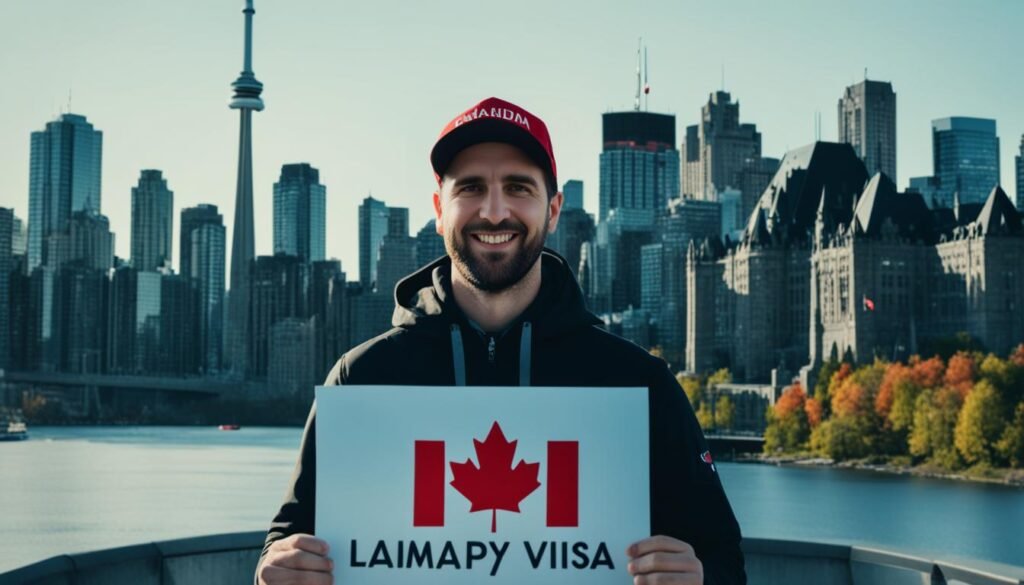How to Apply for a Temporary Work Visa in Canada

As Martin Luther King Jr. once said, "We are not makers of history. We are made by history." This idea is very true when you're dealing with Canada's temporary work visa. If you're a skilled worker, an investor, or a trader, it's key to know how to apply for a visa. This knowledge is vital to join Canada's dynamic workforce.
Canada has two main types of work permits. Some need a Labour Market Impact Assessment (LMIA), while others don't. The LMIA is a document that some employers must get from Employment and Social Development Canada (ESDC) before hiring a temporary foreign worker (TFW). It shows that hiring a TFW won't harm the Canadian job market.
But, thanks to international agreements, some employers can hire TFWs from certain countries without an LMIA. This makes the process easier for some people.
- Understanding Canadian Temporary Work Visas
- Eligibility for LMIA-exempt Temporary Work Visas
- temporary work visa Canada for Professionals
- Intra-Company Transfers (ICTs)
- Other LMIA-exempt Work Situations
- Application Process for Canadian Temporary Work Visas
- Validity and Extension of Canadian Temporary Work Visas
Understanding Canadian Temporary Work Visas
Canada has many temporary work visas for international workers and employers. These visas are split into two main types. One type needs a Labour Market Impact Assessment (LMIA). The other type is LMIA-exempt.
Labour Market Impact Assessment (LMIA)
An LMIA is a document Canadian employers must get to hire a temporary foreign worker. It shows that hiring a TFW will have a good or neutral effect on the job market.
LMIA-exempt Occupations
Some jobs and agreements let Canadian employers hire TFWs without an LMIA. These LMIA-exempt jobs include:
- Traders from the United States, Mexico, Colombia, Chile, South Korea, and Peru
- Investors from the United States, Mexico, Colombia, Chile, South Korea, Peru, the European Union (CETA), the United Kingdom, and CPTPP countries
- Temporary foreign worker professionals from the United States, Mexico, Colombia, Chile, Panama, Peru, GATS Member Nations, and some CPTPP countries
These and other LMIA-exempt jobs give Canadian employers the chance to hire international talent. This helps them meet their work needs.
Eligibility for LMIA-exempt Temporary Work Visas
Canada has different temporary work visa options that don't need a Labour Market Impact Assessment (LMIA). These visas are for certain foreign workers, making it easier for them to work in Canada.
Traders from Specific Countries
Canadian employers can hire traders from the U.S., Mexico, Colombia, Chile, South Korea, or Peru without an LMIA. This is thanks to trade deals like the Canada-United States-Mexico Agreement (CUSMA).
Investors from Specific Countries and Regions
Canadian employers can also hire investors from the U.S., Mexico, Colombia, Chile, South Korea, Peru, the European Union, the United Kingdom, and some Trans-Pacific countries without an LMIA. These visas are made easier by international investment agreements.
"Canada's LMIA-exempt temporary work visa options provide a competitive advantage in attracting top talent from around the world."
temporary work visa Canada for Professionals
Canada's temporary work visa program lets professionals from certain countries work here without needing a Labor Market Impact Assessment (LMIA). Temporary foreign workers (TFWs) from the United States, Mexico, Colombia, Chile, Panama, Peru, GATS member nations, and some Trans-Pacific countries can work for Canadian employers without an LMIA if they are professionals.
What makes someone a "professional" in Canada varies by agreement. Usually, it means they have a job or contract with a Canadian company. They will do work that matches their skills and qualifications. This way, skilled people can work in Canada without the extra paperwork of an LMIA.
"Millions of people shift or temporarily move to Canada for working purposes every year."
The temporary work visa Canada for professionals is great for both employers and workers. It helps share talent and fill skills gaps in the Canadian job market. By knowing who can apply and what's needed, professionals can look into these professional work visa chances. This can boost their career in Canada.
Intra-Company Transfers (ICTs)
The Intra-Company Transfer (ICT) program in Canada lets businesses bring skilled workers from abroad to their offices in Canada. It's great for companies wanting to move executives, senior managers, and experts between their global teams.
Executives, Senior Managers, and Specialized Knowledge Workers
There are three types of workers who can apply: executives, senior managers, and experts in specialized fields. They must have worked for the company abroad for at least a year in the last three years. They also need skills and experience that will help the Canadian branch.
Management and Graduate Trainees
Management and graduate trainees can also move to Canada through the ICT program. They must be part of a training program with the company. This helps them get international work experience.
The Intra-Company Transfer program makes applying easier, with fast processing and the chance for work permit extensions. It can also lead to permanent residency in Canada for the workers and their families.
The ICT program is a key resource for companies worldwide. It helps them use their global talent and grow their Canadian operations.
"The Intra-Company Transfer program has been crucial in bringing specialized skills from our global teams to Canada. It supports the growth of our Canadian operations."
Other LMIA-exempt Work Situations
Canada's temporary work visa program has more than the standard Labour Market Impact Assessment (LMIA) process. There are special cases where international agreements let employers hire workers from certain countries without the LMIA check.
By Occupation: Airline Personnel and Government Workers
Some jobs, like those in the airline industry, don't need an LMIA in Canada. This includes people working in operations, tech, and on the ground. Also, government workers from the United States don't need an LMIA.
By Relationship Status: Spouses of Certain Foreign Nationals
Spouses of people from places like Colombia, South Korea, CPTPP countries, and the European Union can work in Canada without an LMIA. This applies to spouses of those already in Canada on an LMIA-exempt temporary work visa.
These LMIA-exempt work situations give employers more freedom when hiring workers from abroad. They still protect the Canadian job market.
Application Process for Canadian Temporary Work Visas
Applying for a temporary work visa in Canada might seem hard, but it's easier with the right steps. First, figure out what type of visa you need, like an LMIA-based or LMIA-exempt work permit.
The steps to apply are straightforward:
- Visit the nearest Canadian embassy or consulate to get the forms and documents you need.
- Fill out the application form with details about your job, skills, and travel plans.
- Collect the needed documents, like a valid passport, proof of money, a travel plan, and any work or education papers.
- Go to an interview at the embassy or consulate, where they'll ask about your job and plans.
- Pay the visa application fees, which depend on the work permit type.
The temporary work visa Canada application process can take weeks or months. So, apply early to your planned trip date. Being organized and submitting everything fully can make the process smoother and quicker.
If you're applying for a work permit application without an LMIA, the steps are a bit different. But, the main steps are the same. Always check the requirements and deadlines for the visa you're applying for to make sure you apply correctly.
Validity and Extension of Canadian Temporary Work Visas
Canadian temporary work visas are usually valid for the length of your stay, up to 90 days in a 180-day period. It's rare to extend these visas, but it's possible with approval from the Canadian authority in charge of your area.
If you're visiting for less than 6 months and won't work in Canada, a visitor visa might be enough. But if you're staying longer or planning to work, you'll need a temporary work visa.
You must show that your main business and income come from outside Canada. You'll need to pay the biometrics fee when you apply, unless you don't have to. Most of the time, you can only apply online for a visitor visa, except for certain reasons like disability or special documents.
If you want to know other articles similar to How to Apply for a Temporary Work Visa in Canada You can visit the category Apply Now.



Leave a Reply